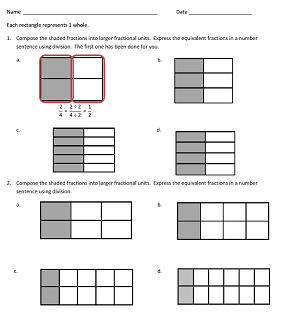Fraction Equivalence Using Division
Related Topics:
Lesson Plans and Worksheets for Grade 4
Lesson Plans and Worksheets for all Grades
More Lessons for Grade 4
Common Core For Grade 4
Videos, examples, and solutions to help Grade 4 students learn how to use the area model and division to show the equivalence of two fractions.
Common Core Standards: 4.NF.1, 4.NF.3b
New York State Common Core Grade 4, Module 5, Lesson 9

Lesson 9 Concept Development
Problem 1: Simplify 6/12 by composing larger fractional units using division.
Problem 2: Simplify both 2/8 and 3/12 as 1/4 by composing larger fractional units.
Problem 3: Simplify both 2/6 and 4/12 as 1/3 by composing larger fractional units.
Lesson 9 Problem Set 1
Each rectangle represents 1 whole.
- Compose the shaded fractions into larger fractional units. Express the equivalent fractions in a number sentence using division. The first one has been done for you.
- Compose the shaded fractions into larger fractional units. Express the equivalent fractions in a number sentence using division.
a. - d.
e. What happened to the size of the fractional units when you composed the fraction?
f. What happened to the total number of units in the whole when you composed the fraction? - a. In the first area model, show 2 sixths. In the second area model, show 3 ninths. Show how both fractions can be renamed as the same unit fraction.
b. Express the equivalent fractions in a number sentence using division.
Lesson 9 Homework
Each rectangle represents one whole. 1. Compose the shaded fractions into larger fractional units. Express the equivalent fractions in a number sentence using division. The first one has been done for you.
2. Compose the shaded fractions into larger fractional units. Express the equivalent fractions in a number sentence using division.
e. What happened to the size of the fractional units when you renamed the fraction?
f. What happened to the total number of units in the whole when you renamed the fraction?
3. a. In the first area model, show 4 eighths. In the second area model, show 6 twelfths. Show how both fractions can be composed, or renamed, as the same unit fraction.
b. Express the equivalent fractions in a number sentence using division.
4. a. In the first area model below, show 4 eighths. In the second area model, show 8 sixteenths. Show how both fractions can be composed, or renamed, as the same unit fraction.
b. Express the equivalent fractions in a number sentence using division.
Try the free Mathway calculator and
problem solver below to practice various math topics. Try the given examples, or type in your own
problem and check your answer with the step-by-step explanations.

We welcome your feedback, comments and questions about this site or page. Please submit your feedback or enquiries via our Feedback page.